The Early History of St. Augustine High School
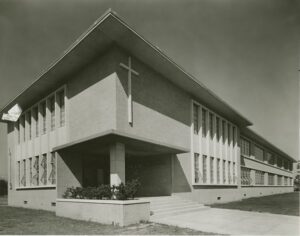
St. Augustine High School, 2600 A. P. Tureaud Avenue (formerly London Avenue)
In 1943, the Very Reverend Edward Casserly, S.S.J., Superior General of the Josephites, wrote that there was a crying need for a Catholic high school for colored boys in New Orleans. The Archdiocese of New Orleans already had three excellent high schools for boys – St. Aloysius, Holy Cross, and Jesuit – but they were only for white males. Many black Catholic parents across the city longed for the day when an all-boys high school would be available for their sons. Xavier Prep (conducted by the Sisters of the Blessed Sacrament) accepted boys, but it was co-ed and could not accommodate the large number of males seeking a Catholic education at the high school level.
Soon after, the Archdiocese announced that since World War II, the population of the city had grown rapidly, and new high schools needed to be built and several others expanded. Under its Youth Progress Program, it was decided that three new high schools in the city would be built, two for whites and one for blacks.
Upon learning this, the Josephites in 1944 offered to staff any future school for colored males. Finally, on March 23, 1950, it was announced that the first Catholic High School would be built solely for colored boys.
Funds for its construction were solicited from Catholic families through the Youth Progress Program. Unfortunately, only $250,000 was allotted to St Augustine (by the Archdiocese) as compared to $400,000 to the other two new high schools. This was a sad commentary on the racial situation at the time and a way to make sure that white donors would not be offended.
The site for the new facility was purchased by the Josephites to whom the operation of the school was entrusted in 1951. Located between Law and Hope streets in the Seventh Ward, it occupied an entire square facing London Avenue, part of which had previously been a grazing area for milk cows.
The Josephite priests and brothers had to agree to three conditions: They had to donate $100,000 to the Archdiocese and build a faculty house within 2 years. They also had to grant forty scholarships to deserving boys, ten for each of the four school years.
The dedication of the new school took place on Sunday, August 26, 1951, with over 3,000 people in attendance. The parishioners of city’s fourteen black Catholic parishes – Corpus Christi, St. Peter Claver, Holy Ghost, St. Raymond, Epiphany, Blessed Sacrament, St Joan of Arc, St. Monica, Holy Redeemer, St. Katherine, All Saints, St. David, St. Philip, and St. Paul – were ecstatic! All of these parishes had elementary schools which would then serve as feeder schools to St. Augustine High School.
Monsignor Henry Bezou, the Superintendent of Catholic Schools, is credited with giving the new school its name, in honor of St. Augustine of Hippo, an early African bishop and Doctor of the Church. The initial staff consisted of six priests and one layman, Mr. George “Nick” Connor. An entrance exam was administered to all potential students at Corpus Christi School. One hundred and fifty students took the test, and four class sections were admitted with 140 students in the freshman class of 1951.
Father Matthew J. O’Rourke was appointed the school’s first principal, serving from 1951-1960. During this period, the principal was considered the disciplinarian. The “board of education” was used when all other means failed. Extracurricular activities such as the Marching 100 and Concert Band, school paper, yearbook, science clubs, debate team, etc. were implemented to expand students’ horizons. The fourth year of school witnessed the first Junior-Senior prom which reluctantly was chaired by Father Robert Pavlak.
Father Robert H. Grant served as St. Aug’s second principal from 1960-1969. This period was known as the school’s “Glory Years.” During these 9 years, St. Augustine had 3 Presidential Scholars, 5 National Merit Scholarships, 18 National Achievement Scholarships, and 40 National Achievement Finalists.
The “Purple Knight” was chosen as the school’s mascot. It served as a symbol of manly virtue. Students were taught to be loyal to God and their school and to never permit anyone, including themselves, to disgrace it in anyway. From its inception, St. Aug was known as a no-nonsense school. Emphasis was placed on discipline in order to create a climate of learning. Competition among the students for the highest grades were encouraged and (in the words of Dr. Daniel Thompson of Dillard University) St. Aug’s greatest achievement was that it “made academics a masculine thing.”
Four years of religious studies for spiritual growth with daily prayers before and after class was implemented. Former New Orleans mayor Sidney Barthelemy, ’60 remembers how the priests called all the students “Mister” at a time when in the rest of society black men were often called “boy,” regardless of their age.
The importance of the role St. Augustine has played in the development of the black community cannot be overstated. As it moves into its eighth decade of service, St. Augustine High School has had to face many challenges in its recent past. Integration has given black males more choices in the schools they can attend. Almost all of the city’s Catholic elementary schools which served as feeder schools to St. Augustine have closed.
In spite of it all, St. Augustine continues to be a shining light in New Orleans and home to thousands of black men who take pride in the fact that they share in their school’s unique and rich history.
The students shown below are members of the first class to enter the school in 1951 and to graduate four years later in 1955. Five of these graduates would eventually return as faculty members: Leonard Augustine, Carl Blouin, Watson Jones, Glendon Taylor, and Lawrence Winchester.
[Click the pictures to enlarge them.]
Sources: Matthew J. O’Rourke, “Between Law and Hope”: St. Augustine High School, New Orleans, Louisiana (Baltimore: Josephite Fathers and Brothers, 2003); The Josephite (yearbook) St. Augustine High School (1955); “Catholics Dedicate $550,000 St. Augustine Boys Hi Here,” The Louisiana Weekly, 1 September 1951, p. 1-2; “67 Receive High School Diplomas at St. Augustine,” The Louisiana Weekly, 4 June 1955, p. 2
Lolita Villavasso Cherrie
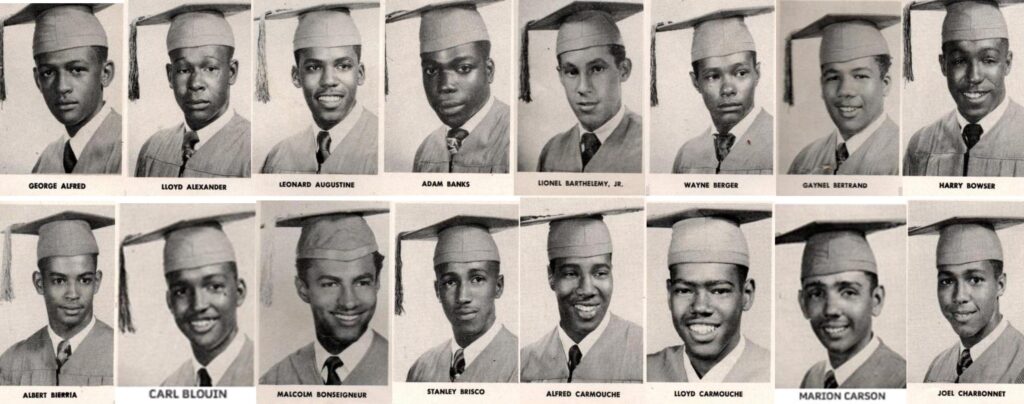
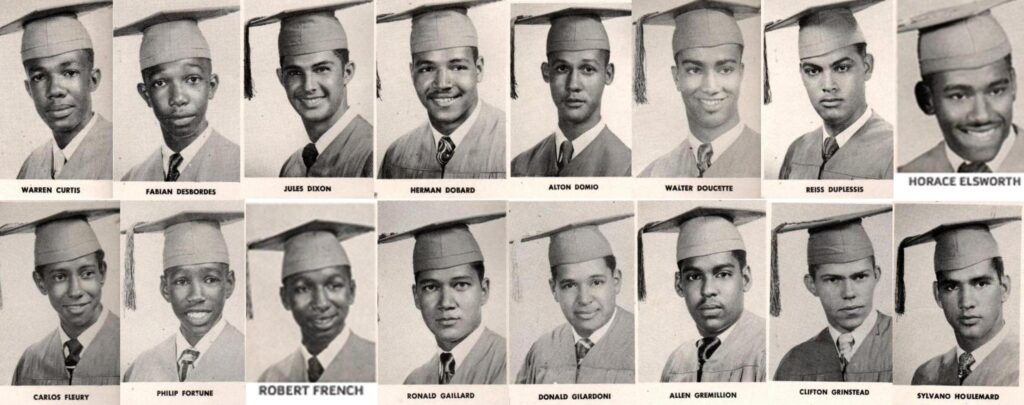
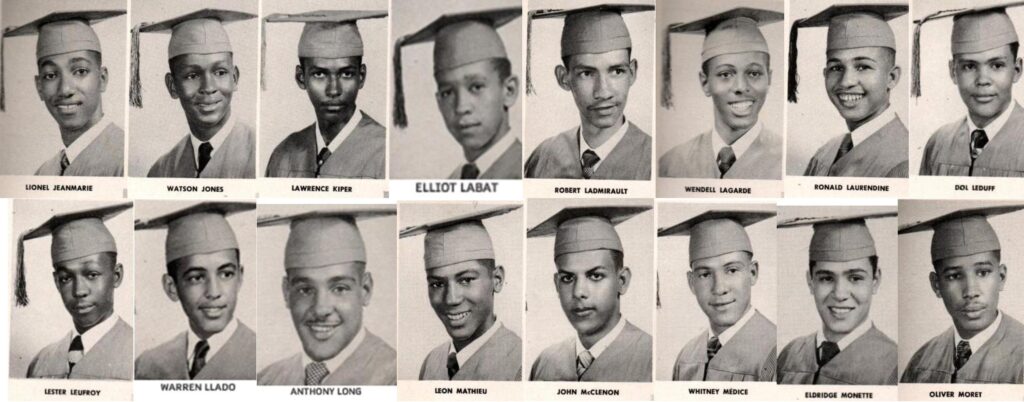
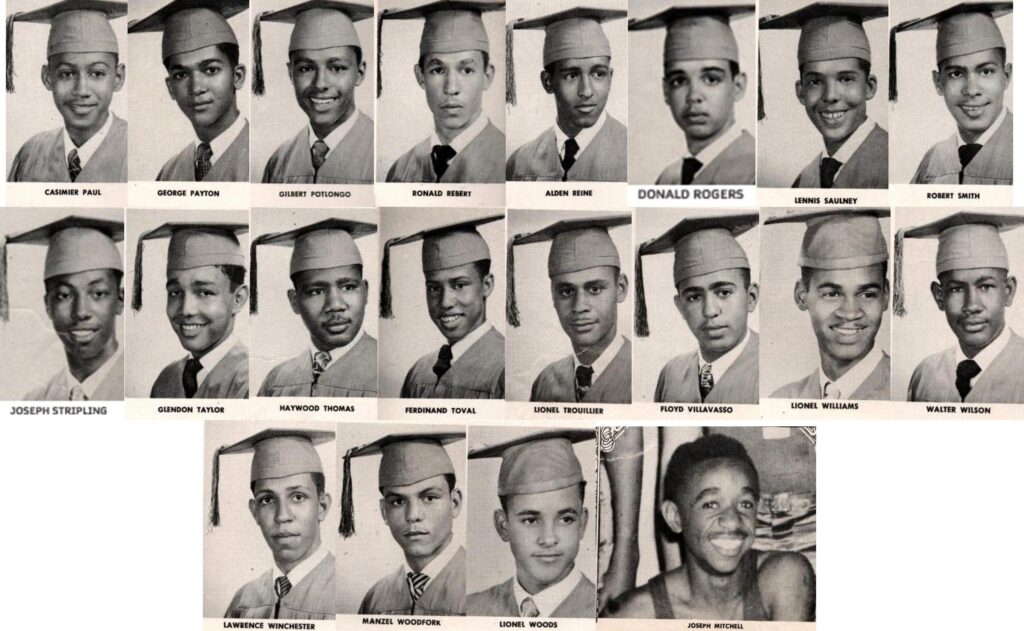



Thank you for this precise and accurate history.
Fr. Matthew J. O’Rourke wrote the book about St Augustine High School. The title is ” Between Law and Hope “. It’s a great read and anyone who is interested in the complete history of ” St. Aug ” should read this book.
I agree, Kevin. “Between Law and Hope” is a great book. Most of today’s students do not know the history behind the names of the schools they attend. It should be required reading of all those presently at St. Aug.
My brother Donald R Gilardoni was in the first graduating class. It was great to read this story.
Great article!
I shared on my social media.
WOW !!!!!!!!
Excellent history and documentation in spite of the many racist acts of the Catholic Diocese. The gymnasium slight comes to mind. St. Aug continues to prosper. Purple forever. Class of 1965.
And still we rise! Great article! Class of 1965.
Yep. Family all in there. My brother Philman Batiste, my ex-husband Michael Graves attended there and and our son Shaunn Joseph Graves and his Uncle Jason Graves graduated from St. Aug.
Another great article of New Orleans cultural hidtory.
Thanks for this information. Kenneth Smith class of 1974
Wonderful History … Proud to be a part of it …
Great history. C/O ’84
Excellent. We all needed to know the history. Class of ‘61
Excellent brother! Excellent! Class of 75
This is a very good article and brings back some fond memories of my early childhood.
I remember when the “cow field” was there. A good friend of my mother’s, The Cojoe family, lived on London Ave. diagonally across the street from where St. Aug was built when I was in my early years in grammar school at St. Raymond’s. We would visit that family and my brothers and I played football in that field with her sons. On one weekend visit, we found that the field was closed off with a fence. The story was that a new high school was being built. Our parents were excited, but we were upset because our playground was being taken! We ended up having to play in the street on London Ave. At that time, the canal in the “neutral ground” was still opened and had concrete sloping walls which were only about 3 or 4 feet deep. That London Avenue Canal emptied into the pumping station on N. Broad St which met with the Florida Ave canal with those deep steep walls. We lost a few footballs in that Florida Ave canal! All of that water was then pumped north into the bigger London Ave canal and out into Lake Pontchartrain.
Fast-forward to the 1960s, and some of us ended up attending and graduating from that same school which took our football playground!
Alan Raphael
St. Aug. class of 1964
Outstanding article on the history of St Aug from its beginning. Brings back pleasant memories of my Class of 64.
Feels great to be a part of this history
Lolita, thank you for this amazing article. I really appreciate being able to read the articles from CreoleGen about the city I was born and raised in. There was so much I didn’t know about what went on during my youth and it is always a joy to recognise the names of people mentioned.
The more we communicate, the more we educate !!!!!!!!!!!
Lolita, you continue to amaze me ! Great story, telling it like it is ! Merci !
Amazing how Out Beloved High School came to be.
Great to know more about my school’s history. Class of 69.
I spent four years at St. Aug graduating in 1966. I was a public school transfer but managed to keep up with the curriculum graduating with honors. The education that I received at the school has been a major reason for my success in life. I was in the Marching 100 and enjoyed seeing the band profiled on 60 Minutes.
What a powerful testament to the glory of St. Augustine and to honor its name. Thank God for the foresight and courage of the priests who helped establish this monument to Black youth at a crucial inflection point in NOLA’s history. Blessings to all and especially Lolitta for a very fine publication of a very fond memory indeed. Philip Orticke (Marching 100, 1958-62)
Thank you Lolita Villavasso Cherrie for this St. Aug history and to all Creolegen researchers for keeping our history alive and published.
Thanks Elise.